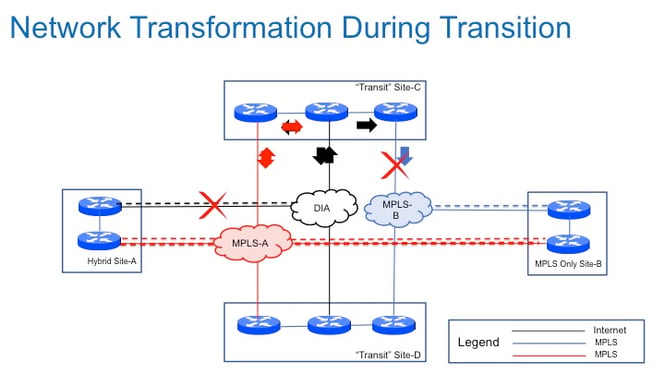Looking back on a couple of intensive days at the New York WAN Summit, one of the highlights for me was a presentation from airline services multinational Gate Group. In it, Garth Gray, the VP of Infrastructure Services, shared his unique business challenges and experience moving from MPLS to a hybrid WAN.
Gate Group is probably the world’s largest airline catering company. It turns over $3 billion and its customer base includes 80% of the world’s major airlines. It employs a staff of 30,000 and runs 160 facilities in 32 countries on six continents. A typical facility caters about 150 flights–or 11,000 meals–each day, and they all run 24/7, because, as Gray’s mantra goes, “We simply can’t afford to make an airline late.” Losing network capability means losing access to core ERP facilities and facing the choice to either overstock the plane and erode already tight (5%) margins, or wait for the network to come back online and risk huge penalties from the airline for delaying the flight.
A Complex, Unwieldy Network
The setup of Gate Group’s old MPLS network probably sounds familiar to some of you. A series of acquisitions meant that the company had a disparate collection of private cloud data centers, ERP platforms, financial planning platforms, fixed telephony platforms—you get the picture. It was managed by half a dozen providers globally, it cost about $4 million to run and was just not doing the job. Each facility was getting about 2 Mbps and couldn’t transact data as it needed to. There was no redundant capacity or resiliency. Gray’s biggest concern was the lack of control, as his team was unable to respond to threats or network failures. They had no visibility over the network and “couldn’t respond intelligently to requests from the business about the lack of performance.” Something had to be done.
Like many enterprises, Gate Group looked at business broadband as an alternative to its expensive and unwieldy configuration of leased lines. Gate Group's audit of its business broadband options revealed an opportunity to provision 10 times the existing bandwidth while improving network control and reducing costs by 25%.
Finding the Right Partners
Interestingly, Gate Group opted to implement the transformation themselves. Unconvinced (in 2013) of the ability of integrators to deliver for them, they relied heavily on the recommendations of Open Systems, a managed security services provider to find ISP partners around the world. Gate Group drew up a set of requirements for each provider—24-hour incident ticketing, service language support and the like—and in the end, established relationships with 15 broadband providers around the world.
The hybrid WAN was first implemented through a pilot project in Asia Pacific, before being rolled out elsewhere. The region was chosen as a test bed because it would be the most challenging to make the transition. The Asia Pacific region was the most underserved by the existing network and constituted the biggest procurement risk for selecting business broadband vendors. The target 16 site roll-out was accomplished in 8 months. Four of those 8 months, however, were spent ironing out problems in the cutover process for the first 4 sites. By the end of the pilot, Gate Group was able to do a cutover in an hour. The result of the new architecture is better visibility and control, a breakout to the Internet at every site, centralized admin, and improved security. Gray was even able to reduce the number of field support staff.

There have been a few problems post-implementation. In one instance, with so much new-found capacity at their fingertips, Gray says everyone went “a bit crazy.” The company had to introduce more stringent governance and control on how the network is used, in order to change user behavior.
Lessons Learned
So what are the takeaways from this experience? The success of the implementation shows that a hybrid WAN can lower costs, improve visibility and all those other good things it promises to do, without compromising security, quality of service or control.
I have some observations on what made this project work:
- Manage expectations. Gray and his team worked hard to sell the proposed change to the business. They made sure the business understood how much the transition would cost, that quality of service would be acceptable, and network management and control would improve. For Gray, the fact that costs could be kept down by using in-house expertise was a key factor in selling the project.
- Good relationships are key. Gate Group found the right partner in managed security services provider Open Systems. Although it had the confidence and expertise to contemplate the transformation on its own, Gate Group relied heavily Open Systems’ input to be assured consistent service and support. Gate Group also maintained a good working relationship with their existing MPLS vendor, Orange. Even though Gate Group did not implement Orange's proposed network redesign, the vendor's help was critical in the transition to the new business broadband solution.
- Take care of security. Security and control are chief among the concerns for any enterprise looking to replace MPLS with direct Internet access. For Gate Group, the decision to work with a managed security service provider was crucial to resolving these concerns.
Greg Bryan
Greg is Senior Manager, Enterprise Research at TeleGeography. He's spent the last decade and a half at TeleGeography developing many of our pricing products and reports about enterprise networks. He is a frequent speaker at conferences about corporate wide area networks and enterprise telecom services. He also hosts our podcast, TeleGeography Explains the Internet.





